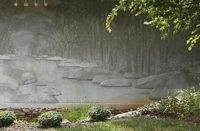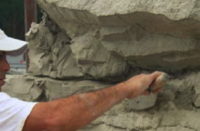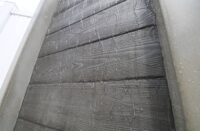It’s a colossal stone fireplace measuring 21 feet at the hearth, with an 18-foot mantel. You can’t miss it. Each massive riverbed boulder has been hefted in place and mortared securely. It’s Old World stone-masonry at its finest, except…it’s not.
The dramatic fireplace display in a Michigan builder’s residence is actually the result of a decorative concrete technique known as vertical carving. In this art form, the artisans carve and color interior or exterior walls, fireplaces, bars, sculptures, fire pits and other structures out of plastic concrete, turning the objects into dead ringers for stone, brick, timber, or whatever non-concrete substance they want to replicate.
It’s Troy Lemon, working out of his Cornerstone Decorative Concrete in Fennville, Mich., who created the massive fireplace you’d swear consists of boulders lovingly stacked high and wide. It’s a prime example of the work of talented artisans with simple hand instruments and boundless concrete design imaginations, energy and know-how.
Rock Studies
“Lines, texture and color, that’s what we’re really talking about,” says carver and educator Nathan Giffin in defining vertical decorative concrete in its most basic sense. If done right, all three of those descriptive elements will come together to achieve authenticity–even though the end result isn’t authentic in a literal sense.
Different techniques are used, but the prime goal of the vertical carving artist is to fool the eye. The concrete design usually, but not always, mimics substances from the natural world. The experts can, and have, designed rooms and spaces to look like caves, grottoes, even mountains and ancient castles. They work indoors and out, for commercial and residential clients all over the world.
Giffin, who owns and operates the education website Vertical Artisans, has carefully examined the work of Lew French, a contemporary stonemason and designer. He’s also visited castles in Spain where he’s studied the production of masons and was fascinated by the “calling cards” the individual craftsman would leave behind. The cryptic designs in stonework are the equivalent of artist signatures or logos for the purpose of winning more work.
Giffin also goes to national parks, quarries and landscaping outlets where he can study stones of all sizes, shapes and varieties.
As he explains, “If you don’t immerse yourself with real rock and know what a fracture actually looks like, how can you possibly recreate it?”
“I’m always looking at rocks,” says Lemon, the Michigan concrete designer. He finds photos in magazines and favors Kentucky’s Red River Gorge area for his informal getaway rock studies.
Tools and Techniques of the Trade
Lemon works in different ways as the job demands, but he might start by installing wood and tar paper over a wall. Then comes an underlayment of a quarter inch of rapid set mortar.
This is followed by a carving mix overlay of about 2 ½ in. Among his favorite products in this category are Brickform Vertical Mix, Imperial Vertical Carving Mix from Kingdom Concrete Products and Trinic Concrete Vertical and Carving Mix. He uses a range of trowels for carving.
After the concrete has cured, usually after at least 24 hours, it’s ready for coloring. This is done with water-based dyes that can be applied with airbrushes, chip brushes, sponges, spray bottles or whatever seems appropriate for the color delivery job.
For his part, Giffin prefers to show as well as tell his favorite methods, techniques and stylings. Vertical Artisans, has a library of over 1,000 tutorial videos, and continues to add to his vast collection of carving data. Some are free, though most reside behind a paywall where entire courses can be purchased. One viral video of his has had 1.5 million views.
Artists and Models
However you define it, vertical concrete carving is still something of a mystery to many clients. As Lemon puts it, “Everyone knows what stamped or polished concrete is, but vertical carving isn’t mainstream yet. It’s a niche technique, so I have to carefully explain it and make a model before I can proceed.”
That model-making is no small task. His preliminary creation can be two or three feet wide or high and might take Lemon four or five hours to create.
Carver and decorative concrete creator Emil Gera, who owns Emil J. Gera Concrete Contractor in the Hazleton area of northeastern Pennsylvania, takes a more high-tech approach to his model production. He does his rendering by a computer program that creates a three-dimensional space. It’s an effort that can take Gera 60 hours before the real work can even begin.
But it’s well worth the time and effort, he says. “When it’s done, I can let my clients view their project from all angles. They can virtually walk through it. I can even change the lighting so they’ll know what the scene will look like in all seasons and times of day.”
Gera has put his virtual models to good use in spearheading the production of a range of high-end interior and exterior vertical carving jobs for clients in the Hazleton, Penn. area. He also creates training displays for World of Concrete and other industry shows, where he shares his time and expertise.
Carving vs. Stamping
Giffin says that the artistry doesn’t always have to actually be vertical. In his view, it qualifies if it’s decorative, and not flatwork. “Even if it’s an inverted surface, such as if you’re carving a Spanish herringbone ceiling to match a kitchen countertop, it’s still vertical carving,” he says.
It’s that word carving that matters most, as far as Giffin is concerned. Creating the effects with a certain skill set that is either learned or acquired in return for a payment is his definition of the vertical decorative carver.
There’s always an easier way to get the job done. Go online, and you’ll quickly find products and instructional videos promoting vertical concrete stamping, or stenciling. Once the mud is poured, you simply use a seemingly countless array of stencils or overlays to stamp the designs of granite, slate, brick, or whatever look you’re after.
There’s something lacking, says Giffin. Vertical stamping is about repetition, since most manufacturers only have about three to five different stencils for a project.
“Your eye figures out the repetition in the design, and once you see it you can’t unsee it,” he says. “It’s especially bad on very large surfaces.”
Nature, after all, has no patterns. No consistency. This randomness is the appeal of the carvings of a talented artisan.
Diverse Beginnings
Lemon and Gera both began pouring concrete from their earliest work years. In both cases, it was functional flatwork that paid their bills before they gravitated to decorative concrete and then vertical carving as an ever-growing subset of that more creative environment.
That’s not a common route Giffin sees in the thousands he’s taught through his website. “I see landscapers, carpet layers, off-duty police officers, lawyers…all walks of life.” Some are drawn to his site to learn the craft, while others just want to get a better idea of what it is so they can hire the work to be done.
Giffin’s own story is equally non-traditional. He had a background in electrical engineering, and then co-owned a software company with a friend. After suffering a financial setback through that partnership, he wasn’t sure what he was going to do with his life.
Then, through his church, he met a man from South Africa. “He said, ‘Let me show you what my family does in Johannesburg. We mix mud on the street, throw it on the brick walls, and carve it to look like stone surfaces.’”
What his new friend then showed Giffin was a three-ring binder of photos of vertical carving projects that changed Giffin’s life. He immediately knew what he was going to do.
“That began my journey. I started inventing the tools I’d need and configured methods and stylings and became very good at creating concrete stonework.”
Good enough, in fact, that some 20 years later, he teaches concrete carving to artisans all over the world, but still makes time for his own projects.
For his latest and perhaps most ambitious endeavor, Giffin is making a mountain 16 feet high and 45 feet long. It will have a foam core center and be cast in concrete that will assume a weathered limestone appearance. There will be a waterfall and a hidden lover’s cave.
Nothing, after all, is impossible for talented vertical concrete carvers with an eye for detail, can-do spirits, and vivid imaginations.





















